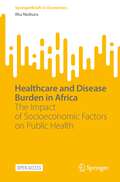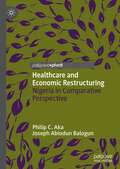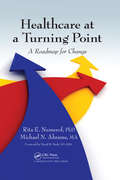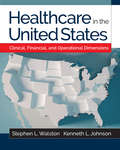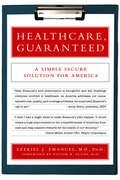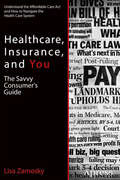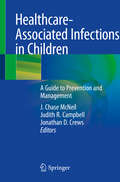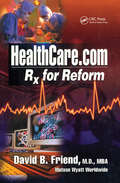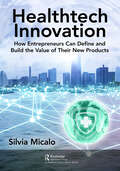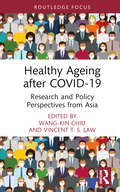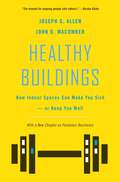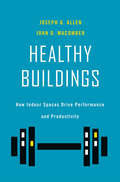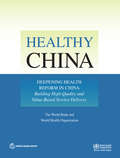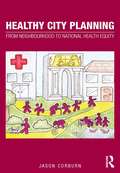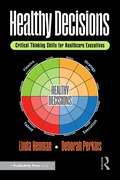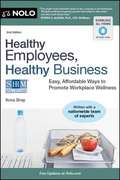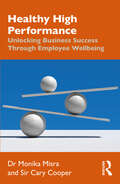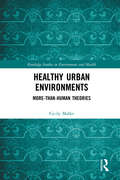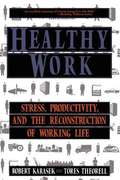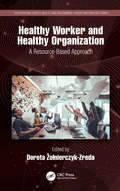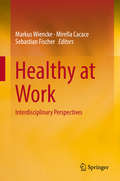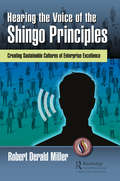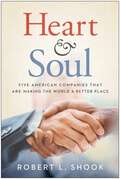- Table View
- List View
Healthcare and Disease Burden in Africa: The Impact of Socioeconomic Factors on Public Health (SpringerBriefs in Economics)
by Ilha NiohuruThis open access book evaluates African healthcare systems from multiple perspectives. By examining empirical data from various African countries, it analyzes the effects of socioeconomic factors such as urbanization, population growth, and education on various health indicators, including the situation of health professionals, patients's decision making, health resource distribution, mortality rates, and the burden of disease. Furthermore, topics such as the use of social media in healthcare and insurance policy in Africa are addressed. This book appeals to scholars and professionals interested in healthcare in Africa.
Healthcare and Economic Restructuring: Nigeria in Comparative Perspective
by Philip C. Aka Joseph Abiodun BalogunThis book explores the intersection between healthcare delivery and national economic health, using Nigeria as case study and window into the world. Specifically, the issue this book tackles revolves around how to repair Nigeria’s dysfunctional healthcare system through the medium of a healthier economy that provides sufficient revenue to meet the healthcare needs of citizens.
Healthcare at a Turning Point: A Roadmap for Change
by Michael Abrams Rita E. NumerofIf the furious debate around the state of healthcare in the US has led to any consensus, it‘s that the system should be delivering better quality for less cost than it does. The truth is that our healthcare system is a sprawling mix of competing interests in which those of the patient are valued least. Too much discussion has devolved to simplistic
Healthcare in the United States: Clinical, Financial, and Operational Dimensions
by Kenneth L. Johnson Stephen L. WalstonHealthcare in the United States: Clinical, Financial, and Operational Dimensions offers an introductory overview of the American healthcare system by exploring its many organizations, populations, professions, structures, financing, and delivery models, as well as their impact. Authors Stephen L. Walston and Kenneth L. Johnson delve into the many conflicting issues related to cost, access, and quality. The book's 14 chapters cover the following and more: a comprehensive review of the health professions and types of healthcare organizations; an exploration of how medical providers are paid; major challenges currently facing physicians, hospitals, and the pharmaceutical industry; an examination of the long-term and mental healthcare sectors and the increasing demands for their services; the significant role of the government in healthcare, including the influence of politics; the basics of population health, including an in-depth look at how changing social, demographic, and economic conditions in the United States affect healthcare; the connections between health behaviors, health insurance, and health outcomes; information technology's role in healthcare; a comparison of US healthcare to that in other countries, with a focus on the four basic models on which most healthcare systems are created. To enhance and assess students' learning, each of the book's chapters features case studies, thought-provoking questions and assignments, sidebars, and key terms accompanied by definitions. As they read, future healthcare administrators and clinicians will obtain a grounding in the multifaceted US healthcare system, thus enabling them to better address its multiple priorities, controversies, and opportunities.
Healthcare, Guaranteed: A Simple, Secure Solution For America
by Ezekiel EmmanuelAmerica spends more than any other developed nation on healthcare-$2. 1 trillion in 2007 alone. But 47 million Americans remain uninsured, and of those Americans who are insured, many suffer from poor health. In his ground-breaking proposal, Dr. Ezekiel Emanuel offers up a plan to comprehensively restructure the delivery and quality of our healthcare. By eliminating employer-healthcare and establishing an independent program to evaluate healthcare plans and insurance companies, he offers a no-nonsense guide to how government can institute private insurance options that will allow each of us a choice of doctor and plan. With the rate of healthcare costs rapidly outpacing our gross domestic product, we can no longer afford to maintain our fragmented delivery of care, or entertain reforms that seek to patch, rather than cure, a fractured system. Accessible, straightforward, and revolutionary in its approach, Healthcare, Guaranteed is an inarguable guide to lasting healthcare reform.
Healthcare, Insurance, and You
by Lisa ZamoskyHealthcare is changing and you need to know how--and what to do about it. Getting good medical care shouldn't be so confusing--or so costly. Healthcare, Insurance, and You simplifies the many confusing details about our healthcare system so you can make informed decisions. Result? Better health at lower cost. With the advent of healthcare reform, things are changing--especially when it comes to insurance. Most people will now have to buy insurance. Do you know where to get a policy or what to look for in one? Did you know more people will now qualify for free or subsidized healthcare? Even if you get insurance through work, you'll face new choices that you'd better understand to maintain your peace of mind. As this book shows, the failure to understand how insurance and the healthcare system work can have a major impact on your physical and financial health. Healthcare, Insurance, and You is an easy-to-use guide that explains the main challenges you face when trying to get excellent healthcare: choosing the best insurance policy for your situation, finding the right doctor or hospital, buying prescription drugs the least expensive way, picking out the right Medicare plan, or fighting for your rights when dealing with insurers or medical providers. Healthcare, Insurance, and You includes tips, resources, and strategies for navigating the healthcare system and avoiding common mistakes so you can get the best healthcare for you, your family, or your organization without breaking the bank. This book shows you: How to choose a health plan that best meets your medical and financial needs, including new options under the Affordable Care Act Ways to cut through red tape and fight billing errors and claim denials What businesses need to know about offering--or not offering--insurance to employees How to plan ahead for a disability or for end-of-life care Healthcare costs rank high on the list of money concerns Americans have. And when it comes to getting great healthcare for you and your family and avoiding crippling medical bills, knowledge is power. Healthcare, Insurance, and You is a practical guide that explains the complicated healthcare system in plain language--and puts the power of good health back in your hands. What you'll learn The impact of the Affordable Care Act on your healthcare and your finances How to take advantage of new health insurance exchanges and tax credits How to choose a health plan that best meets your medical and financial needs How to advocate for yourself, fight billing errors and denied claims, and know where to turn for help How to choose a doctor and hospital based on quality, not hype How to avoid common mistakes that can cost you big--or even put you into bankruptcy How health reform affects businesses and how they can reduce healthcare expenditures Who this book is for Consumers of healthcare in the United States, including both individuals and small businesses buying coverage for employees. Table of Contents A New Healthcare System Buying Health Insurance on your own Paying for Health Insurance Health Insurance at Work Cutting Medical Costs Buying Prescription Drugs You Against the Healthcare System Medicare Taking Charge of Your Healthcare Future Consumer Assistance Programs and State Departments of Insurance
Healthcare-Associated Infections in Children: A Guide to Prevention and Management
by J. Chase McNeil Judith R. Campbell Jonathan D. CrewsWith advances in technology and medical science, children with previously untreatable and often fatal conditions, such as congenital heart disease, extreme prematurity and pediatric malignancy, are living longer. While this is a tremendous achievement, pediatric providers are now more commonly facing challenges in these medical complex children both as a consequence of their underlying disease and the delivery of medical care. The term healthcare-associated infections (HAIs) encompass both infections that occur in the hospital and those that occur as a consequence of healthcare exposure and medical complexity in the outpatient setting. HAIs are associated with substantial morbidity and mortality for the individual patient as well as seriously taxing the healthcare system as a whole. In studies from the early 2000s, over 11% of all children in pediatric intensive care units develop HAIs and this figure increases substantially if neonatal intensive care units are considered. While progress has been made in decreasing the rates of HAI in the hospital, these infections remain a major burden on the medical system. In a study published in 2013, the annual estimated costs of the five most common HAIs in the United States totaled $9.8 billion. An estimated 648,000 patients developed HAIs in hospitals within the US in 2011 and children with healthcare-associated bloodstream infection have a greater than three-fold increased risk of death.While a number of texts discuss HAIs in the broader context of infectious diseases or pediatric infectious diseases (such as Mandell’s Principles and Practice of Infectious Diseases or Long and Pickering’s Principles and Practice of Pediatric Infectious Diseases) no single text specifically focuses on the epidemiology, diagnosis and management of HAI in children. Many infectious diseases texts are organized based on the microbiology of infection and from this starting point then discussing the clinical syndromes associated with the organism of interest. For instance, a chapter on Staphylococcus aureus may contain a brief discussion of the role of S. aureus in surgical site infections in the wider context of all staphylococcal disease. For clinicians caring for children at the bedside, however, the clinical syndrome is typically appreciated and intervention necessary prior to organism identification. We propose a text that details both the general principles involved in HAIs and infection prevention but also provides a problem oriented approach. Such a text would be of interest to intensivists, neonatologists, hospitalists, oncologists, infection preventionists and infectious diseases specialists. The proposed text will be divided into three principle sections: 1) Basic Principles of Infection Control and Prevention, 2) Major Infectious Syndromes and 3) Infections in Vulnerable Hosts. Chapters in the Major Infectious Syndromes section will include discussion of the epidemiology, microbiology, clinical features, diagnosis, medical management (or surgical management as appropriate) and prevention of the disease entity of interest. Chapters will seek to be evidenced based as much as possible drawing from the published medical literature as well as from clinical practice guidelines (such as those from the Infectious Diseases Society of America) when applicable. We intend to include tables, figures and algorithms as appropriate to assist clinicians in the evaluation and management of these often complex patients. Finally, we intend to invite authors to participate in this project from across a number of medical specialties including infectious diseases, infection control, critical care, oncology and surgery to provide a multidisciplinary understanding of disease. It is our intent to have many chapters be co-written by individuals in different subspecialties; for instance, a chapter on ventilator-associated pneumonia may be co-written by both infectious disease and critical care medicine specialists. Such a unique text has the potential to provide important guidance for clinicians car
Healthcare.com: Rx for Reform
by David FriendDespite more than a decade of change, the U.S. health care delivery system is still in the early stages of its transformation into a truly effective, cost efficient and compassionate system. In Healthcare.com: RX for Reform, Dr. David Friend, trained in both medicine and business, delineates the symptoms of our ailing healthcare system and offers a vision for the future. Even with the enormous turmoil our health care system has undergone - from the proliferation managed care to the closing of hospitals - large numbers of people continue to receive sub-optimal care. The author discusses several symptoms including: increasing costsuncertain quality of careeroding trust in health care vendorsincreasing prospect of shareholder liabilitydeclining access to providersunclear impact on employee productivityIt is time to discard the old, traditional way of thinking about healthcare and take a fresh look at its issues and challenges. To tackle these challenges we must strike a balance between the seemingly dissimilar disciplines of economics, medicine, technology, and politics. Dr. Friend proposes that we tear down the brick and mortar delivery model and replace it with a Virtual Health Care System. This new model changes the roles of everyone involved in the healthcare system, from the patient to the healthcare provider. It utilizes technology to redesign health care so that it can be delivered with higher quality and greater efficiency. Healthcare.com: RX for Reform examines the actions necessary for the evolution of our current system into a Virtual Health Care System.Features
Healthtech Innovation: How Entrepreneurs Can Define and Build the Value of Their New Products
by Silvia MicaloToday, over 500,000 medical technologies are available in hospitals, homes, and community care settings. They range from simple bandages to complex, multi-part body scanners that cost millions of dollars to develop. Yet a typical technology has a lifecycle of just 21 months before an improved product usurps it—the healthcare ecosystem is rapidly advancing and driven by a constant flow of innovation. And those innovations need innovators. With $21 billion made available for investment in the digital healthcare industry in 2020 (a 20x increase on 2010), entrepreneurs, investors, and related actors are entering the healthcare ecosystem in greater numbers than ever before. Last year alone, over 17,000 medical technology patents were filed, the third highest of all patent types. Each of those has a dedicated team of entrepreneurs behind it. Yet with increasingly strict regulations and pharmaceutical giants growing more aggressive, many thousands of entrepreneurs fail before even the patent stage: just 2% secure revenue or adoption. Healthtech Innovation: How Entrepreneurs Can Define and Build the Value of Their New Products is a down-to-earth survival guide for entrepreneurs struggling to secure a strategic position within the healthtech ecosystem. Which is expected that by 2026, the global digital health market size will be around $657 billion. This book is designed to help innovators navigate this complex and newly volatile landscape. It covers business strategy, marketing, funding acquisition, and operation in a global regulatory context. It is written in simple language, evidenced by the latest academic and industry research, and explained using real-world examples and case studies.
Healthy Ageing after COVID-19: Research and Policy Perspectives from Asia (ISSN)
by Wang-Kin Chiu and Vincent T. S. LawWritten by researchers and experienced health professionals from Hong Kong, China, Chiu and Law identify and examine important issues of healthy ageing after COVID-19 from research and policy perspectives in the Asian contexts.This book opens with discussions of healthy ageing from personal, social, economic, and political perspectives. These discussions make reference to the key characteristics of a community health model. It aims to examine the impacts of the COVID-19 pandemic on aged care in an international perspective, citing the fifth wave of COVID-19 in Hong Kong as a case report. Comprehensive analysis on the influence of COVID-19 infection on Hong Kong and the implemented anti-pandemic policy measures, as well as recommendations of post-pandemic policies to promote healthy ageing, are provided. This monograph also reviews the worldwide impacts on aged care during and after the pandemic, as well as the experience of aged care services in Hong Kong and other Asia-Pacific regions. The responding changes in policies and strategies for healthy ageing in selected countries are also reviewed. This monograph ends with a highlight on the design and development of a community model for healthy ageing, providing insights to the achievement of sustainable healthy ageing with reference to the sustainable development goal (SDG) 3.A valuable resource to governments, politicians, academics, and practitioners, it is intended for formulating future directions of relevant research, and the design and implementation of interventions for the promotion of healthy ageing in the post-pandemic era.
Healthy Buildings: How Indoor Spaces Can Make You Sick—or Keep You Well
by John D. Macomber Joseph G. AllenA revised and updated edition of the landmark work the New York Times hailed as “a call to action for every developer, building owner, shareholder, chief executive, manager, teacher, worker and parent to start demanding healthy buildings with cleaner indoor air.”For too long we’ve designed buildings that haven’t focused on the people inside—their health, their ability to work effectively, and what that means for the bottom line. An authoritative introduction to a movement whose vital importance is now all too clear, Healthy Buildings breaks down the science and makes a compelling business case for creating healthier offices, schools, and homes.As the COVID-19 crisis brought into sharp focus, indoor spaces can make you sick—or keep you healthy. Fortunately, we now have the know-how and technology to keep people safe indoors. But there is more to securing your office, school, or home than wiping down surfaces. Levels of carbon dioxide, particulates, humidity, pollution, and a toxic soup of volatile organic compounds from everyday products can influence our health in ways people aren’t always aware of.This landmark book, revised and updated with the latest research since the COVID-19 pandemic, lays out a compelling case for more environmentally friendly and less toxic offices, schools, and homes. It features a concise explanation of disease transmission indoors, and provides tips for making buildings the first line of defense. Joe Allen and John Macomber dispel the myth that we can’t have both energy-efficient buildings and good indoor air quality. We can—and must—have both. At the center of the great convergence of green, smart, and safe buildings, healthy buildings are vital to the push for more sustainable urbanization that will shape our future.
Healthy Buildings: How Indoor Spaces Drive Performance and Productivity
by John D. Macomber Joseph G. Allen“This book should be essential reading for all who commission, design, manage, and use buildings—indeed anyone who is interested in a healthy environment.” —Norman Foster A forensic investigator of “sick buildings” and Director of Harvard’s Healthy Buildings Program teams up with a CEO-turned–Harvard Business School professor to reveal the secrets of a healthy building—and unlock one of the greatest business opportunities of our time. By the time you reach eighty, you will have spent seventy-two years of your life indoors. Like it or not, humans have become an indoor species. This means that the people who design, build, and maintain our buildings can have a major impact on our health. Ever feel tired during a meeting? That’s because most offices and conference rooms are not bringing in enough fresh air. When that door opens, it literally breathes life back into the room. But there is a lot more acting on your body that you can’t feel or see. From our offices and homes to our schools and hospitals, the indoor spaces where we work, learn, play, eat, and heal have an outsized influence on our performance and wellbeing. They affect our creativity, focus, and problem-solving ability and can make us sick—dragging down profits in the process. Charismatic pioneers of the healthy building movement who have paired up to combine the cutting-edge science of Harvard’s School of Public Health with the financial know-how of the Harvard Business School, Joseph Allen and John Macomber lay out the science of healthy buildings and make the business case for owners, developers, and CEOs. They reveal the 9 Foundations of a Healthy Building, and show how tracking health performance indicators with smart technology can boost performance and create economic value. While the “green” building movement tackled energy, waste, and water, the new healthy building movement focuses on the most important (and expensive) asset of any business: its people.
Healthy China: Building High-Quality and Value-Based Service Delivery
by The World Bank;World Health OrganizationThe report recommends that China maintain the goal and direction of its healthcare reform, and continue the shift from its current hospital-centric model that rewards volume and sales, to one that is centered on primary care, focused on improving the quality of basic health services, and delivers high-quality, cost-effective health services. With 20 commissioned background studies, more than 30 case studies, visits to 21 provinces in China, the report proposes practical, concrete steps toward a value-based integrated service model of healthcare financing and delivery, including: 1) Creating a new model of people-centered quality integrated health care that strengthens primary care as the core of the health system. This new care model is organized around the health needs of individuals and families and is integrated with higher level care and social services. 2) Continuously improve health care quality, establish an effective coordination mechanism, and actively engage all stakeholders and professional bodies to oversee improvements in quality and performance. 3) Empowering patients with knowledge and understanding of health services, so that there is more trust in the system and patients are actively engaged in their healthcare decisions. 4) Reforming public hospitals, so that they focus on complicated cases and delegate routine care to primary-care providers. 5) Changing incentives for providers, so they are rewarded for good patient health outcomes instead of the number of medical procedures used or drugs sold. 6) Boosting the status of the health workforce, especially primary-care providers, so they are better paid and supported to ensure a competent health workforce aligned with the new delivery system. 7) Allowing qualified private health providers to deliver cost-effective services and compete on a level playing field with the public sector, with the right regulatory oversight, and 8) Prioritizing public investments according to the burden of disease, where people live, and the kind of care people need on a daily basis.
Healthy City Planning: From Neighbourhood to National Health Equity (Planning, History and Environment Series)
by Jason CorburnHealthy city planning means seeking ways to eliminate the deep and persistent inequities that plague cities. Yet, as Jason Corburn argues in this book, neither city planning nor public health is currently organized to ensure that today’s cities will be equitable and healthy. Having made the case for what he calls ‘adaptive urban health justice’ in the opening chapter, Corburn briefly reviews the key events, actors, ideologies, institutions and policies that shaped and reshaped the urban public health and planning from the nineteenth century to the present day. He uses two frames to organize this historical review: the view of the city as a field site and as a laboratory. In the second part of the book Corburn uses in-depth case studies of health and planning activities in Rio de Janeiro, Nairobi, and Richmond, California to explore the institutions, policies and practices that constitute healthy city planning. These case studies personify some of the characteristics of his ideal of adaptive urban health justice. Each begins with an historical review of the place, its policies and social movements around urban development and public health, and each is an example of the urban poor participating in, shaping, and being impacted by healthy city planning.
Healthy Decisions: Critical Thinking Skills for Healthcare Executives
by Linda Henman Deborah PerkinsIn the wake of an international pandemic, Healthy Decisions: Critical Thinking Skills for Healthcare Executives emerges as a crucial guide for leaders navigating the complex world of healthcare management. This thought-provoking book challenges the status quo, arguing that the success of healthcare organizations hinges not on abstract concepts like "culture," but on the concrete decisions executives make. Drawing from real-world experience with large systems like Mercy and Banner Health, specialty hospitals like Ranken Jordan Pediatric Bridge Hospital, insurance companies like Blue Cross Blue Shield, and nonprofit elder care systems, the authors provide a practical guide to help healthcare executives make the tough decisions they can’t afford to get wrong. With more than eight decades of combined consulting experience with diverse healthcare organizations, the authors present a compelling case for the paramount importance of decision-making in healthcare leadership. They argue that executives must embrace the messy, pragmatic reality of running healthcare organizations. This book offers a roadmap for healthcare leaders who want to move beyond vague discussions of culture and focus on the specific, high-stakes decisions that shape the climate of their organizations. Healthy Decisions offers a fresh perspective on organizational climate, asserting that it's shaped by a series of daunting decisions, not nebulous factors. The book provides invaluable insights into: The pitfalls of using "culture" as a convenient excuse for organizational failures The important role of well-developed analytical thinking skills in effective leadership Strategies for making difficult decisions more consistently, quickly, and accurately Real-world examples and research findings that illuminate the path to better decision-making The dispassionate thinking skills needed to assess risks and tradeoffs effectively How to inspire teams to embrace change, disruption, and innovation This essential roadmap equips healthcare executives with the tools to unlock their decision-making potential, avoid the traps of indecision, and ultimately improve the health of their organizations. Whether you're a seasoned healthcare leader or an aspiring executive, Healthy Decisions will transform your approach to leadership and organizational success in an increasingly uncertain world.
Healthy Employees, Healthy Business
by Ilona Bray J.D.Money-saving steps to improve employee health and productivity -- and your bottom line As health care costs skyrocket, small business owners are increasingly concerned about the impact they're likely to have on company profits. Employee illness, chronic poor health, low job satisfaction, and high turnover lead to lower productivity and contribute heavily to lost company earnings. Healthy Employees, Healthy Business draws on the expertise of an advisory board of doctors, lawyers, benefits specialists, workplace wellness planners and other experts to offer struggling small business owners and managers like you the essential advice you need to implement a low-cost or even free wellness program for your employees. Clear, concise and filled with success stories from other workplaces, you'll get the tools you need to start your wellness program immediately, resulting in increased productivity and potentially lower health insurance costs. Find out how to: evaluate and target your workplace's main health concerns develop fun, effective activities to improve employee health boost morale through mutual support and competition lower workplace stress leverage community resources for minimal financial investment From simply changing the snacks in the vending machines to ensuring that ill employees have access to treatment, you'll get practical advice in Healthy Employees, Healthy Business that will help even the smallest business save money and enjoy a dynamic get helpful forms and interviews with expert advisers. All forms can be downloaded from Nolo.com
Healthy High Performance: Unlocking Business Success Through Employee Wellbeing
by Monika Misra Cary CooperThe Covid-19 pandemic, with its resulting lockdowns and significant changes to ways of working, has provided the opportunity to redefine the potential role that health and wellbeing can play within organisations.Empowering employees to work in ways that optimise their performance, acknowledging both personal and work demands, has created a new work paradigm that had previously not been considered. All savvy organisations will take this as a point in time to rethink business and HR practice, for the benefits of employees and employers. Written by the Head of Associate Health and Wellbeing (Europe) at Mars Incorporated, Dr Monika Misra, and world-renowned expert on wellbeing in organisations, Sir Cary Cooper, the book provides clear evidence of what worked well during the Covid-19 pandemic that we can learn from and embed today, to enable individuals and organisations to thrive. Basing recommendations on a robust evidence base and through real-life practices within organisations, they provide a framework for a four-level response at organisational, team, management and individual levels.This book will provide an essential resource to stimulate company leaders, managers and HR, to rethink and reframe new approaches that enhance employee wellbeing, engagement and performance.
Healthy Urban Environments: More-than-Human Theories (Routledge Studies in Environment and Health)
by Cecily MallerSet in the ‘human–environment’ interaction space, this book applies new theoretical and practical insights to understanding what makes healthy urban environments. It stems from recognition that the world is rapidly urbanising and the international concern with how to create healthy settings and liveable cities in the context of a rapidly changing planet. A key argument is that usual attempts to make healthy cities are limited by human-centrism and bifurcated, western thinking about cities, health and nature. Drawing on the innovative ‘more-than-human’ scholarship from a range of disciplines, it presents a synthesis of the main contributions, and how they can be used to rethink what healthy urban environments are, and who they are for. In particular, the book turns its attention to urban biodiversity and the many non-human species that live in, make and share cities with humans. The book will be of interest to scholars and students in human geography, health sociology, environmental humanities, public health, health promotion, planning and urban design, as well as policymakers and professionals working in these fields.
Healthy Work: Stress, Productivity, And The Reconstruction Of Working Life
by Robert A. Karasek Tores TheorellEvidence is accumulating that in many contemporary work environments people are literally working themselves to death. Based on a ten-year study of nearly five thousand workers, this path-breaking book identifies a clear connection between work-related illness and workers' lack of participation in the design and outcome of their labors.
Healthy Worker and Healthy Organization: A Resource-Based Approach (Occupational Safety, Health, and Ergonomics)
by Dorota Żołnierczyk-ZredaThis book presents research on the determinants of workers’ health (physical and mental well-being) and the organization’s health (performance and culture). It addresses the impact of psychosocial working conditions on workers’ well-being, and their performance, productivity, innovation, and morale at work. Discusses how to manage workers to enable them to be engaged and creative Raises employee awareness on how to maintain good physical and mental health at work Covers how to work beyond retirement age Presents how to design a work environment that prevents counterproductive behaviors Covers work–life balance and how it can affect work This book is aimed at professionals, postgraduate students, scientists, and practitioners in the fields of work and health psychology, management, occupational health and safety, and human resource management.
Healthy at Work
by Sebastian Fischer Markus Wiencke Mirella CacaceThis book aims at exploring the link between corporate and organizational culture, public and private policy, leadership and managerial skills or attitudes, and the successful implementation of work-related healthcare in Europe. Therefore it brings together a wide range of empirical and theoretical contributions from occupational health, management, psychology, economics, and (organizational) sociology to address the question of how to sustainably promote occupational health. Such important questions are answered as: What aspects of a corporate culture can be associated with health issues? How does leadership style affect the health of employees? How are health-related decisions in the workplace affected by the political environment? To what extent are interventions influenced by corporate culture, leadership and public policy? How can we make such interventions sustainable?
Healthymagination at GE Healthcare Systems
by V. Kasturi Rangan Vineet KumarJeff Immelt, the CEO of GE, introduced a new innovation strategy named "healthymagination" in Spring 2009. With cost, quality, and access as its three pillars, healthymagination ensures a strong focus for new product introduction efforts all around GE. But will this focus enable GE to achieve and maintain market leadership across a healthcare market that is being buffeted by strong currents, including cost pressures, changes in chronic disease patterns, and rationalization of buyer behavior? Moreover, healthcare spending is also increasing in emerging economies, which could provide a strong growth engine for the future. Tom Gentile, the CEO of GE Healthcare Systems (GEHS), a key player in the Medical Imaging market, wonders how the innovation strategy might respond to these changes. GE has historically been a technology leader, selling the most advanced equipment to a variety of medical establishments. Will a complete shift to healthymagination allow GE to demonstrate strong organic growth through innovation, as Immelt had charged executives at GE?
Hearing the Voice of the Shingo Principles: Creating Sustainable Cultures of Enterprise Excellence
by Robert Derald MillerFor more than 50 years, organizations of all types have struggled to achieve lasting benefits from the many tools and programs associated with various continuous-improvement initiatives. In fact, the notion of "continuous" improvement is largely a misnomer -- for many organizations, continuous improvement has been anything but continuous. Responding to this challenge, Hearing the Voice of the Shingo Principles chronicles key insights that went into development of the Shingo Model for Operational Excellence at Utah State University. While responsible for the Shingo Prize at USU, the author observed that even recipients -- theoretically, the best of the best -- were experiencing this same up-and-down phenomenon. It was as though many of these organizations were reviewed on their very best days but then started declining from that point forward. To build long-term credibility of the Shingo Prize, the author and his team had to understand what was causing such wide variation in results and make certain they were only recognizing those organizations that could demonstrate sustainability of improvements over the long term. They found that sustainability depended less on application of the tools for improvement than on embedding principles deep into the culture of the organization from top to bottom and side to side. This book helps leaders understand their role in building sustainable cultures of enterprise excellence – That is, how to keep the entire enterprise focused on guiding principles that will change beliefs, behaviors, and the overall mindset. In addition, managers will learn how to align systems with principles so that they drive ideal, principle-based behaviors – the goal is for every leader to realign their values with the voice of principles and become an example so that every associate becomes self-motivated to continuously improve every aspect for which they are accountable.
Heart & Sold
by Valerie FitzgeraldHeart and Sold is an insightful journey through the emotional and tangible challenges of regaining one's personal power while building and maintaining a successful business -- regardless of the country's economic situation. Valerie Fitzgerald, one of the country's leading real estate agents, candidly recounts her personal journey from unemployed single parent to entrepreneur, philanthropist, and renowned corporate executive. From beginners just getting started in residential real estate to seasoned agents -- or anyone in business looking to take their game to the next level -- this step-by-step guide teaches readers the art of selling. With her personal touch, Fitzgerald shows readers how to manage clients with style, choose the right company and the best mentor, establish a stellar reputation in their field, develop a daily schedule for running a home office, and maintain a successful attitude every day. With all of her tools at their fingertips, readers will also soon be shooting for the stars. Heart and Sold shares the mind-set of a respected businesswoman who gracefully balances the demands of an empire with the intimacy of her family, and is a model for working and living that can be applied to any desire or discipline.
Heart & Soul: Five American Companies That Are Making the World A Better Place
by Robert L. ShookIn Heart & Soul, Shook takes readers on heartwarming journeys through some of America's most successful companies: Mary Kay (Dallas), whose primary focus has always been to be a vehicle for women's success and independence in a world that often supports neither; the company now has more than 2 million women working toward their dreams in 37 countries DaVita (Los Angeles/Denver), dedicated to becoming the world's best dialysis company. America's number-one provider of dialysis treatment, DaVita treats its patients and employees like family members. InRETURN (Cincinnati), a company that intentionally employs those with brain injuries and other neurological challenges World Wide Technology (St.Louis), the largest African-American–owned business in the nation, which thrives on biblical principles of fairness and caring Starkey Laboratories (St.Paul/Minneapolis), whose employees travel to remote places to provide more than 50,000 hearing aids to the poor To the employees of these companies, success is measured by the good they accomplish in the world. However, profiting and caring aren't mutually exclusive—these companies demonstrate how any company of any size can do both.
